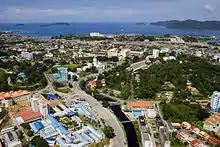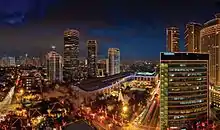BIMP-EAGA
The Brunei Darussalam-Indonesia-Malaysia-Philippines East ASEAN Growth Area (BIMP-EAGA) was launched in 1994 in Davao City.[1] It is located in one of the world's most resource-rich areas in Southeast Asia and includes the Heart of Borneo and the Sulu-Sulawesi Marine Ecoregion.[2]
BIMP-EAGA East ASEAN Growth Area | |
|---|---|
 Coat of arms
| |
| Type | Subregional economic co-operation |
| Members | 4 Countries
|
| Establishment | 24 March 1994 |
Background
BIMP-EAGA was launched in 1994 as a co-operation initiative by Brunei Darussalam, Indonesia, Malaysia and the Philippines, all of which are member-countries of the regional Association of Southeast Asian Nations (ASEAN). The objective behind the creation of BIMP-EAGA is to accelerate economic development in the four countries' "focus areas" which, although geographically distant from their national capitals, are in strategic proximity to each other, in one of the world's most resource-rich regions. The initiative is market-driven and operates through a decentralised organisation structure involving the four governments and the private sector.
BIMP-EAGA co-operation aims to increase trade, tourism and investments inside and outside the subregion by facilitating the free movement of people, goods and services, making the best use of common infrastructure and natural resources, and taking the fullest advantage of economic complementation
Geography
BIMP-EAGA covers a land area of 1.6 million square kilometres and has a combined population of 57.5 million. It comprises the entire sultanate of Brunei Darussalam; the provinces of Kalimantan, Sulawesi, Maluku, West Papua and Papua in Indonesia; the states of Sabah and Sarawak, and the federal territory of Labuan in Malaysia; the island of Mindanao and the province of Palawan in the Philippines. It encompasses two of the world's largest rainforests (in Borneo and Papua), and biodiverse marine systems in the South China Sea, Celebes Sea, and Sulu Sea.
BIMP-EAGA has a long history of participation in the global economy, stretching back to the silk route and spice trade between Europe, China and other parts of Asia, as well as the Galleon trade with the Americas. EAGA supplies the export markets of ASEAN, North and South Asia, and the Middle East, following the expansion of its air, shipping and land transport links, and the development of investment incentives.
Key sectors
Agro-industry. Major agriculture products include coconut, palm oil, livestock and poultry, and high-value tropical fruits and vegetables. EAGA areas are focusing on expanded production, complementation, processing and export, to supply speciality markets such as the halal food trade.
Fisheries. The subregion is a global centre for the production and processing of important marine products, with tuna and seaweed among its major exports.
Tourism. The subregion is a leading ecotourism destination. It has pristine rainforests and vast coral reefs, and is ethnically and culturally diverse. Tourist activities include visits to cultural sites, as well as diving, snorkelling, trekking, mountain climbing, game fishing, and other adventure sports. Twenty-two World Heritage Sites are in EAGA, eight are in Indonesia; five are in Malaysia; nine are in the Philippines.
Transport and Shipping. The subregion is connected by sea and air to most major cities in Asia. To ensure its competitiveness, the subregion is in the process of upgrading its airports and seaports, and implementing multilateral agreements to facilitate cross-border movement.
Energy. Energy resources are abundant in the subregion. In addition to oil, natural gas and coal resources, there are investment opportunities in the renewable energy sector, taking advantage of geothermal, biomass, hydro and wind power.
EAGA institutions
Brunei Darussalam, Indonesia, Malaysia, the Philippines and Timor Leste hold an annual Senior Officials Meeting and Ministers Meeting (SOMM) which serves as the main consultative body for EAGA co-operation. A National Secretariat for each member country coordinates in-country and subregional activities.
The BIMPT -EAGA Facilitation Centre (BIMPT-FC) was established in 2003 for co-ordination among the organisations engaged in the BIMPT-EAGA initiative, and support implementation of activities consonant with the BIMPT-EAGA Development Roadmap.
Working Groups formulate action plans for priority sectors, and assist in implementing flagship programs and projects. The Working Groups focus on: air linkages, sea linkages, construction, telecommunications/ICT, agro-industry, fisheries, forestry and environment, energy, joint tourism development, capital formation and financial services, and CIQS (customs, immigration, quarantine and security). The Working Groups are grouped into four Clusters that co-ordinate and integrate their activities.
The private sector participates in the Working Groups by providing inputs for policy formulation, helping prioritise projects, and implementing cross-border economic projects. The BIMPT-EAGA Business Council (BEBC) is an umbrella organisation for the private sector in the subregion and enjoys "fifth country" status in EAGA co-operation.
Selected urban centres

- Kalimantan: Balikpapan, Banjarmasin, Pontianak, Samarinda
- Sulawesi: Bitung, Makassar, Manado, Pare-Pare
- Maluku: Ternate
- Papua: Jayapura, Manokwari

- Sabah: Kota Kinabalu, Lahad Datu, Sandakan, Tawau
- Sarawak: Bintulu, Kuching, Miri, Sibu
- Labuan
- Mindanao: Davao City, General Santos, Zamboanga City, Cotabato City
- Palawan: Puerto Princesa
BIMP-EAGA air transport liberalisation
In April 2007, 4th BIMP-EAGA Transport, Infrastructure and ICT Development Cluster Meeting, the EAGA working group on air linkages agreed to grant fifth freedom traffic rights (FFTR) to all passenger and cargo services in the airports of Bandar Seri Begawan in Brunei Darussalam; Balikpapan and Pontianak in Indonesia; Kota Kinabalu and Kuching in Malaysia; Davao City and Zamboanga City in the Philippines. Additional FFTR designated points in BIMP-EAGA are Manado and Tarakan in Indonesia; Labuan and Miri in Malaysia; Puerto Princesa and General Santos in the Philippines.
Implementation of the Fifth Freedom Traffic rights have been targeted in the air routes as a result of the signing of the Memorandum of Understanding on the Expansion of Air Linkages in BIMP-EAGA during the 3rd BIMP-EAGA Summit recently held in Cebu City on 12 January 2007. As part of the road map, full liberalisation of FFTR in BIMP-EAGA are scheduled by December 2008.
- Bandar Seri Begawan – Kota Kinabalu – Davao City,
- Bandar Seri Begawan – Kuching – Pontianak,
- Bandar Seri Begawan – Kota Kinabalu, and
- Bandar Seri Begawan – Kuching
Recent added FFTR points agreed in 2013 include Tawau, Mulu, Makassar, and Cagayan de Oro. Cebu, Solo, and Johor Baru will be added as co-terminalisation points.
Possible future inclusion
In 2019, Thailand through their ambassador in Malaysia Narong Sasitorn announced their interest to be part of the BIMP-EAGA via Kota Kinabalu.[3]
Selected sources
See also
References
- "BIMP-EAGA: Turning remote, isolated areas into economic engines". Asian Development Bank. 24 June 2019. Retrieved 15 August 2019.
- "Brunei Darussalam-Indonesia-Malaysia-Philippines East ASEAN Growth Area (BIMP-EAGA)". Asian Development Bank. 22 January 2018. Retrieved 15 August 2019.
- "Thailand sees KK as main gateway to Bimp-Eaga". Bernama. The Borneo Post. 22 August 2019. Retrieved 22 August 2019.
Thailand Ambassador to Malaysia Narong Sasitorn said the country was hoping to be part of Brunei, Indonesia, Malaysia and Philippines-East Asia Growth Area (Bimp-Eaga) via Kota Kinabalu.


